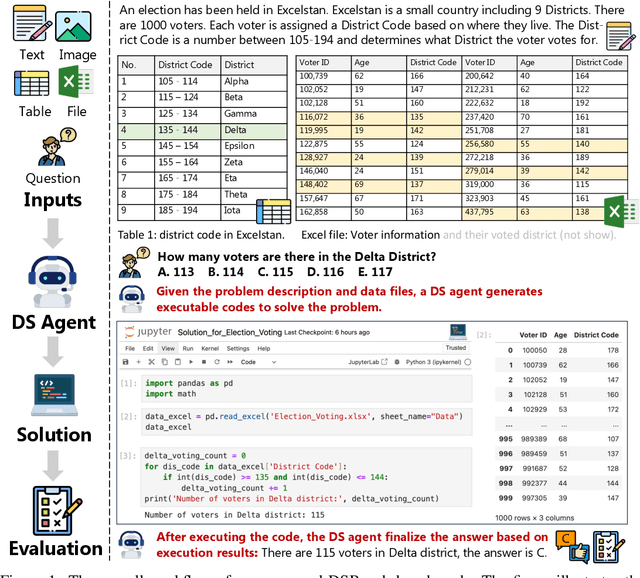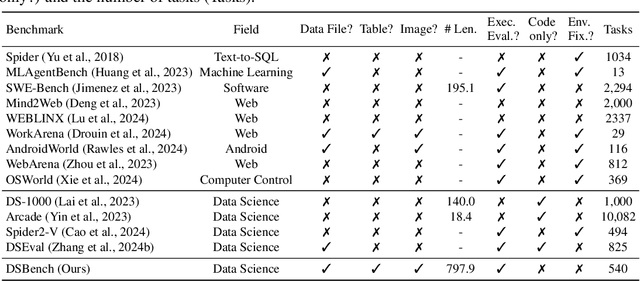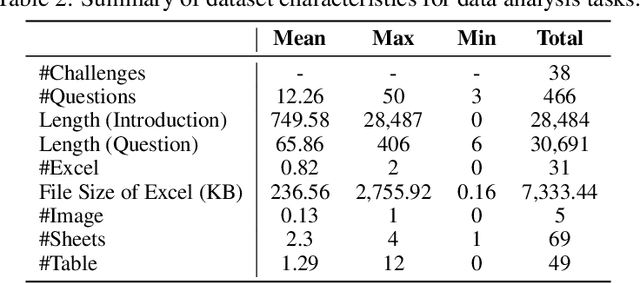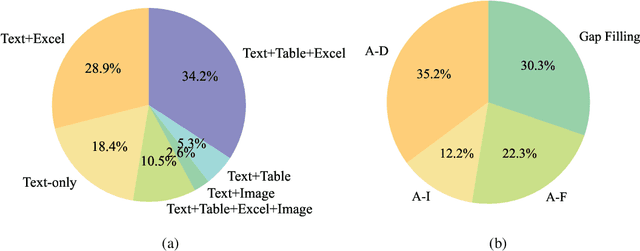Kaixin Ma
OpenWebVoyager: Building Multimodal Web Agents via Iterative Real-World Exploration, Feedback and Optimization
Oct 25, 2024



Abstract:The rapid development of large language and multimodal models has sparked significant interest in using proprietary models, such as GPT-4o, to develop autonomous agents capable of handling real-world scenarios like web navigation. Although recent open-source efforts have tried to equip agents with the ability to explore environments and continuously improve over time, they are building text-only agents in synthetic environments where the reward signals are clearly defined. Such agents struggle to generalize to realistic settings that require multimodal perception abilities and lack ground-truth signals. In this paper, we introduce an open-source framework designed to facilitate the development of multimodal web agent that can autonomously conduct real-world exploration and improve itself. We first train the base model with imitation learning to gain the basic abilities. We then let the agent explore the open web and collect feedback on its trajectories. After that, it further improves its policy by learning from well-performing trajectories judged by another general-purpose model. This exploration-feedback-optimization cycle can continue for several iterations. Experimental results show that our web agent successfully improves itself after each iteration, demonstrating strong performance across multiple test sets.
DivScene: Benchmarking LVLMs for Object Navigation with Diverse Scenes and Objects
Oct 03, 2024



Abstract:Object navigation in unknown environments is crucial for deploying embodied agents in real-world applications. While we have witnessed huge progress due to large-scale scene datasets, faster simulators, and stronger models, previous studies mainly focus on limited scene types and target objects. In this paper, we study a new task of navigating to diverse target objects in a large number of scene types. To benchmark the problem, we present a large-scale scene dataset, DivScene, which contains 4,614 scenes across 81 different types. With the dataset, we build an end-to-end embodied agent, NatVLM, by fine-tuning a Large Vision Language Model (LVLM) through imitation learning. The LVLM is trained to take previous observations from the environment and generate the next actions. We also introduce CoT explanation traces of the action prediction for better performance when tuning LVLMs. Our extensive experiments find that we can build a performant LVLM-based agent through imitation learning on the shortest paths constructed by a BFS planner without any human supervision. Our agent achieves a success rate that surpasses GPT-4o by over 20%. Meanwhile, we carry out various analyses showing the generalization ability of our agent.
LEOPARD : A Vision Language Model For Text-Rich Multi-Image Tasks
Oct 02, 2024Abstract:Text-rich images, where text serves as the central visual element guiding the overall understanding, are prevalent in real-world applications, such as presentation slides, scanned documents, and webpage snapshots. Tasks involving multiple text-rich images are especially challenging, as they require not only understanding the content of individual images but reasoning about inter-relationships and logical flows across multiple visual inputs. Despite the importance of these scenarios, current multimodal large language models (MLLMs) struggle to handle such tasks due to two key challenges: (1) the scarcity of high-quality instruction tuning datasets for text-rich multi-image scenarios, and (2) the difficulty in balancing image resolution with visual feature sequence length. To address these challenges, we propose \OurMethod, a MLLM designed specifically for handling vision-language tasks involving multiple text-rich images. First, we curated about one million high-quality multimodal instruction-tuning data, tailored to text-rich, multi-image scenarios. Second, we developed an adaptive high-resolution multi-image encoding module to dynamically optimize the allocation of visual sequence length based on the original aspect ratios and resolutions of the input images. Experiments across a wide range of benchmarks demonstrate our model's superior capabilities in text-rich, multi-image evaluations and competitive performance in general domain evaluations.
Cognitive Kernel: An Open-source Agent System towards Generalist Autopilots
Sep 16, 2024



Abstract:We introduce Cognitive Kernel, an open-source agent system towards the goal of generalist autopilots. Unlike copilot systems, which primarily rely on users to provide essential state information (e.g., task descriptions) and assist users by answering questions or auto-completing contents, autopilot systems must complete tasks from start to finish independently, which requires the system to acquire the state information from the environments actively. To achieve this, an autopilot system should be capable of understanding user intents, actively gathering necessary information from various real-world sources, and making wise decisions. Cognitive Kernel adopts a model-centric design. In our implementation, the central policy model (a fine-tuned LLM) initiates interactions with the environment using a combination of atomic actions, such as opening files, clicking buttons, saving intermediate results to memory, or calling the LLM itself. This differs from the widely used environment-centric design, where a task-specific environment with predefined actions is fixed, and the policy model is limited to selecting the correct action from a given set of options. Our design facilitates seamless information flow across various sources and provides greater flexibility. We evaluate our system in three use cases: real-time information management, private information management, and long-term memory management. The results demonstrate that Cognitive Kernel achieves better or comparable performance to other closed-source systems in these scenarios. Cognitive Kernel is fully dockerized, ensuring everyone can deploy it privately and securely. We open-source the system and the backbone model to encourage further research on LLM-driven autopilot systems.
DSBench: How Far Are Data Science Agents to Becoming Data Science Experts?
Sep 12, 2024



Abstract:Large Language Models (LLMs) and Large Vision-Language Models (LVLMs) have demonstrated impressive language/vision reasoning abilities, igniting the recent trend of building agents for targeted applications such as shopping assistants or AI software engineers. Recently, many data science benchmarks have been proposed to investigate their performance in the data science domain. However, existing data science benchmarks still fall short when compared to real-world data science applications due to their simplified settings. To bridge this gap, we introduce DSBench, a comprehensive benchmark designed to evaluate data science agents with realistic tasks. This benchmark includes 466 data analysis tasks and 74 data modeling tasks, sourced from Eloquence and Kaggle competitions. DSBench offers a realistic setting by encompassing long contexts, multimodal task backgrounds, reasoning with large data files and multi-table structures, and performing end-to-end data modeling tasks. Our evaluation of state-of-the-art LLMs, LVLMs, and agents shows that they struggle with most tasks, with the best agent solving only 34.12% of data analysis tasks and achieving a 34.74% Relative Performance Gap (RPG). These findings underscore the need for further advancements in developing more practical, intelligent, and autonomous data science agents.
COLUMBUS: Evaluating COgnitive Lateral Understanding through Multiple-choice reBUSes
Sep 06, 2024



Abstract:While visual question-answering (VQA) benchmarks have catalyzed the development of reasoning techniques, they have focused on vertical thinking. Effective problem-solving also necessitates lateral thinking, which remains understudied in AI and has not been used to test visual perception systems. To bridge this gap, we formulate visual lateral thinking as a multiple-choice question-answering task and describe a three-step taxonomy-driven methodology for instantiating task examples. Then, we develop COLUMBUS, a synthetic benchmark that applies the task pipeline to create QA sets with text and icon rebus puzzles based on publicly available collections of compounds and common phrases. COLUMBUS comprises over 1,000 puzzles, each with four answer candidates. While the SotA vision-language models (VLMs) achieve decent performance, our evaluation demonstrates a substantial gap between humans and models. VLMs benefit from human-curated descriptions but struggle to self-generate such representations at the right level of abstraction.
DOCBENCH: A Benchmark for Evaluating LLM-based Document Reading Systems
Jul 15, 2024



Abstract:Recently, there has been a growing interest among large language model (LLM) developers in LLM-based document reading systems, which enable users to upload their own documents and pose questions related to the document contents, going beyond simple reading comprehension tasks. Consequently, these systems have been carefully designed to tackle challenges such as file parsing, metadata extraction, multi-modal information understanding and long-context reading. However, no current benchmark exists to evaluate their performance in such scenarios, where a raw file and questions are provided as input, and a corresponding response is expected as output. In this paper, we introduce DocBench, a new benchmark designed to evaluate LLM-based document reading systems. Our benchmark involves a meticulously crafted process, including the recruitment of human annotators and the generation of synthetic questions. It includes 229 real documents and 1,102 questions, spanning across five different domains and four major types of questions. We evaluate both proprietary LLM-based systems accessible via web interfaces or APIs, and a parse-then-read pipeline employing open-source LLMs. Our evaluations reveal noticeable gaps between existing LLM-based document reading systems and human performance, underscoring the challenges of developing proficient systems. To summarize, DocBench aims to establish a standardized benchmark for evaluating LLM-based document reading systems under diverse real-world scenarios, thereby guiding future advancements in this research area.
MARVEL: Multidimensional Abstraction and Reasoning through Visual Evaluation and Learning
Apr 24, 2024Abstract:While multi-modal large language models (MLLMs) have shown significant progress on many popular visual reasoning benchmarks, whether they possess abstract visual reasoning abilities remains an open question. Similar to the Sudoku puzzles, abstract visual reasoning (AVR) problems require finding high-level patterns (e.g., repetition constraints) that control the input shapes (e.g., digits) in a specific task configuration (e.g., matrix). However, existing AVR benchmarks only considered a limited set of patterns (addition, conjunction), input shapes (rectangle, square), and task configurations (3 by 3 matrices). To evaluate MLLMs' reasoning abilities comprehensively, we introduce MARVEL, a multidimensional AVR benchmark with 770 puzzles composed of six core knowledge patterns, geometric and abstract shapes, and five different task configurations. To inspect whether the model accuracy is grounded in perception and reasoning, MARVEL complements the general AVR question with perception questions in a hierarchical evaluation framework. We conduct comprehensive experiments on MARVEL with nine representative MLLMs in zero-shot and few-shot settings. Our experiments reveal that all models show near-random performance on the AVR question, with significant performance gaps (40%) compared to humans across all patterns and task configurations. Further analysis of perception questions reveals that MLLMs struggle to comprehend the visual features (near-random performance) and even count the panels in the puzzle ( <45%), hindering their ability for abstract reasoning. We release our entire code and dataset.
SemEval-2024 Task 9: BRAINTEASER: A Novel Task Defying Common Sense
Apr 22, 2024



Abstract:While vertical thinking relies on logical and commonsense reasoning, lateral thinking requires systems to defy commonsense associations and overwrite them through unconventional thinking. Lateral thinking has been shown to be challenging for current models but has received little attention. A recent benchmark, BRAINTEASER, aims to evaluate current models' lateral thinking ability in a zero-shot setting. In this paper, we split the original benchmark to also support fine-tuning setting and present SemEval Task 9: BRAIN-TEASER(S), the first task at this competition designed to test the system's reasoning and lateral thinking ability. As a popular task, BRAINTEASER(S)'s two subtasks receive 483 team submissions from 182 participants during the competition. This paper provides a fine-grained system analysis of the competition results, together with a reflection on what this means for the ability of the systems to reason laterally. We hope that the BRAINTEASER(S) subtasks and findings in this paper can stimulate future work on lateral thinking and robust reasoning by computational models.
WebVoyager: Building an End-to-End Web Agent with Large Multimodal Models
Jan 28, 2024Abstract:The advancement of large language models (LLMs) leads to a new era marked by the development of autonomous applications in the real world, which drives innovation in the creation of advanced web-based agents. Existing web agents typically only handle one input modality and are evaluated only in simplified web simulators or static web snapshots, greatly limiting their applicability in real-world scenarios. To bridge this gap, we introduce WebVoyager, an innovative Large Multimodal Model (LMM) powered web agent that can complete user instructions end-to-end by interacting with real-world websites. Moreover, we propose a new evaluation protocol for web agents to address the challenges of automatic evaluation of open-ended web agent tasks, leveraging the robust multimodal comprehension capabilities of GPT-4V. We create a new benchmark by gathering real-world tasks from 15 widely used websites to evaluate our agents. We show that WebVoyager achieves a 55.7% task success rate, significantly surpassing the performance of both GPT-4 (All Tools) and the WebVoyager (text-only) setups, underscoring the exceptional capability of WebVoyager in practical applications. We found that our proposed automatic evaluation achieves 85.3% agreement with human judgment, paving the way for further development of web agents in a real-world setting.
 Add to Chrome
Add to Chrome Add to Firefox
Add to Firefox Add to Edge
Add to Edge